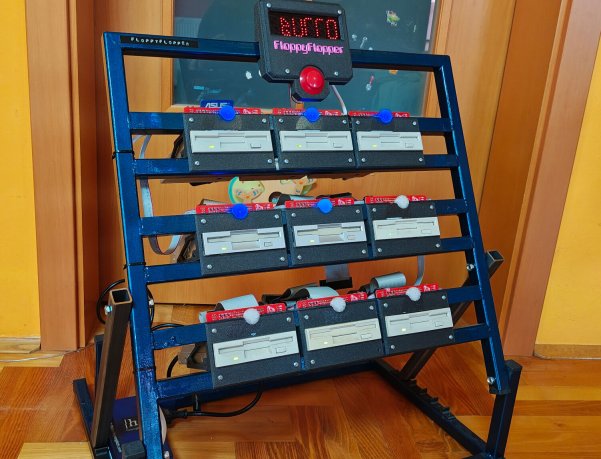
About
There's a special charm in the simple act of inserting and removing a floppy disk. The whole tactile experience has always been one of my quiet joys and it's weirdly satisfying. However, nowadays, you don't really get a chance do that. This project aims to bring back that feeling by turning the act of using floppy disks into a game.
The device consists of a nine floppy disk drives arranged in a 3x3 grid. Each drive has an RGB LED. When a drive LED starts blinking in some color, the floppy disk of the same color (there are floppies with red, green and blue stickers) must be inserted into that drive. For each successful insertion, the player scores 13 points. The available time decreases as the game progresses making it harder to do it. If the player fails to insert the floppy in time the game ends and the final score is displayed on the screen.
I had a really terrible ligting when I was shooting the video, but some noise, film grain and glitches made it look somewhat better.
The device is currently exhibited Rijeka, Croatia, until the December 5th, 2025, as part of the RADIONA's "Automata" exhibition: https://radiona.org/izlozba-automata-surogat-strojevi-galerija-filodrammatica-drugo-more/
Hardware
Besides the nine floppy drives (thanks to Fran and Matko who donated them!), the machine consists of:
- welded steel frame
- PCB for each floppy drive
- main controller board with display and button
- power supply
Steel frame
This summer I got a TIG welding machine for the staircase I'm building (there will be a separate post about this :)) and I sort of learned how to weld. Getting some experience with metal works, significantly expanded the means of production available to me, so I decided to make the steel frame for the game. I didn't want to spend too much time on it, and I sort of liked a half-finished/hacked aesthetics for this, so I just welded the steel tubes and added a coat of paint (the side tubes aren't even painted). The frame can be "closed" for transport or "open", with adjustable inclination, for playing the game.

Floppy drive PCBs
I needed a way to detect which floppy is in the drive. First idea was to actually read the data from the floppy disk, but that was too complicated and unnecessary for this project. Intead, I decided to use the write-protect and density holes on the floppy disk to encode the color information.
The status of the write protect hole can be read from the floppy drive interface. It can also provide the information if floppy is inserted or not. Unfortunately, the density hole status is not available from the drive interface so I had to solder an additional wire to the drive to get that information.
To be able to read the write protect status and the floppy presence, a motor needs to be spinned/powered on. To simplify the whole thing I decided to design a simple PCB with the floppy drive connector, a LED and a microcontroller. The microcontroller gets the command or request from the main controller board through a serial interface and either sets the LED color or returns the status. All PCBs are connected in paralled to the UART bus but have their TX pins configured as open-drain so that only one PCB can safely talk at a time.
Some years ago, while I was working at the university IT department and we were throwing away old stuff, I got a big cardboard box full of floppy disks . It's mostly some drivers and OS installations disks but also some student homeworks. I plan to decorate some wall with them one day. But for now it came in handy to find some number of same type disks.
Main controller board
For the main controller board I wanted some display to show the score. And I decided to reuse the prototype of this year's DORS/CLUC badge which has a quite nice matrix display.

Source
All of the source files for the project including the PCB designs, 3D models and firmware code are available on Bitbucket: https://bitbucket.org/igor_b/floppyflopper/.



